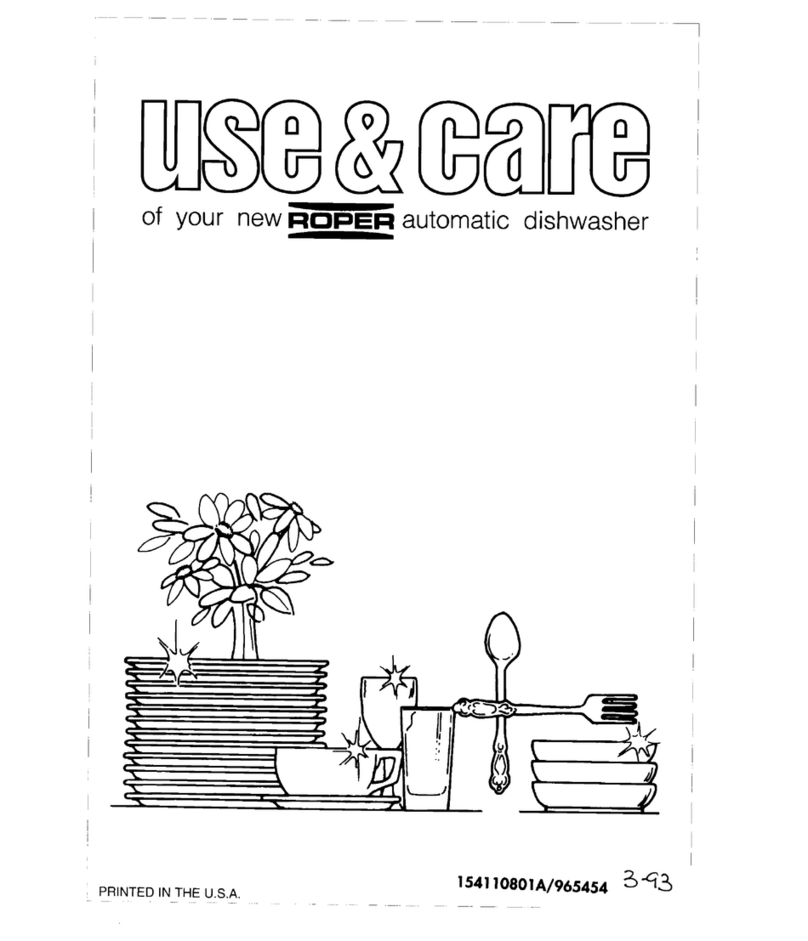Roper 408 User manual

Undercounter Dishwashers
Useand
CareGuide
i’
Thank you for choosinga
Roperappliance.
This Useand Care Guide will help you
operate and maintain your new, quality-
built Roperundercounter dishwasher.
Keepthis Useand Care Guide in a safe
place for future reference.
Completeand mail the
ProductRegistration Card.
This card enters your warranty into our
warranty system that ensures efficient
claim processing, can be used asaproof
of purchase for insurance claims and
helps Roperto contact you immediately
in the unlikely event of aproduct-safety
recall.
You areresponsible for
It is your responsibility to be sure your
dishwasher:
. Is installed by a qualified installer.
. Hasbeen installed where it is
protected from the elements.
n
Hasbeen installed on afloor strong
enough to support its weight.
n
Hasbeen properly connected to
electricity, water and drain.*
n
Hasbeen properly electrically
grounded.*
n
Hashad all hang tags and
temporary labels removed.
l
Is not used by children or anyone
unable to operate it properly.
mIs properly maintained.
l
Seeinstallation Instructions for
complete information.
Home Appliances
Contents
Page
Importent Safety Imtructlonr
Energy Saving Tips z
Using Your Dishwasher
Beforestartingdishwasher i
Startingdishwasher
3
Cyclesandoptions
(modelswith onecyde) 4
Cyclesendoptions
(modelswith threecycles)
4
Cydesandoptions
(modelswith threebuttons)
5
Cydesandoptions
(modelswith fivebuttons)
5
Cycles
andoptions
(modelswith sevenbuttons)
To add a dish after starting ;
Changing a setting
Proper Loading ::
Top rack
loading
Bottomrackloading 3
Silverwarebasketloading
Adding Detergent :
Using Rinee Agent
For
Best Results t
Dishwasher Care And Cleaning
Common Dlshwashlng Problems - ::
Before You Call For Service
WaITi3Ilty :z
Howto getserviceorassistance__

Important Safety Instructions
To reduce the risk
of
fire, electrical shock, or injuxy when wing your diehwasher, follow
basic precautionr including the following:
1. Readall lnstructlons before using
the dishwasher.
2. Properly connect to electricity and
water.
3. DISHWASHERMUSTBE
ELECTRICALLYGROUNDED.
Readthe Installation Instructions
for details.
4. Besure your dishwasher is
installed on a level Boorthat will
hold the weight, and in an area
suitable for its size and use.
5. When discarding an old
dishwasher, always remove the
door to prevent accidental
entrapment or suffocation.
6. REMEMBER,use your dishwasher
only for the job it was designed to
do.
7. Storedishwasher detergent in a
cool,dry place WHERECHILDREN
CAN’T REACHIT.
8. UseONLY detergents and rinse
agents recommendedfor use in a
dishwasher.
9. Locate sharp items and knives so
that they arenot likely to damage
door seal or cut the user.
10. DONOTlet children play in or on
the dishwasher.
11. DONOT reach into the areabelow
the bottom rack until the heating
element has cooledfor at least 20
minutes.
12. DONOTwash plastic items unless
marked “Dishwasher Safe” or the
equivalent. If not marked, check
manufacturer’s recommendations.
13. DONOT use your dishwasher
unless all enclosure panels are
properly in place.
14. DONOT sit on, stand on or abuse
the dishwasher door or dish racks.
15. DONOT tamper with controls.
16. If hot water has not been used
recently (usually two weeks or
longer), hydrogen gasesmay build
up in the water heater and the hot
water pipes. HYDROGENGASIS
EXPLOSIVE.To prevent injury or
damage,before using your
dishwasher, turn on all hot water
faucets and allow water to run for
several minutes. This will allow
gasesto escape.Donot smokeor
use any open flame near the faucet
while it is open.
17. Disconnect electrical power to the
dishwasher before attempting to
service.
18. DONOT store or use gasoline or
other flammable vapors and liquids
in the vicinity of this or any other
appliance. The fumes can createa
fire hazard or explosion.
SAVETHESEINSTRUCTIONS
Energy Saving Tips
You can help saveenergy if you: 4. Load correctly for best washing
1.Washfull loads. Running a half- results. Incorrect loading may cause
filled dishwasher uses the same poor washing and the need to
amount of electricity and hot water rewash all or part of the load.
asafully loaded machine. 5.Donot pre-rinse normally soiled
2.If your model has the Light Wash dishes. Selectthe correct cycle for
Cycle, use it whenever possible. the load and use the recommended
The cycle uses less hot water and amount of detergent for good
energy than the Normal Wash washing results without hand
Cycle. rinsing.
3.Air dry dishes when you don’t need
arapid drying cycle. Allow longer
drying times (overnight). Usea
rinse agent to improve drying.
6.Useyour dishwasher during off-
peak hours. Local utilities
recommendthis to avoid heavy
usage of energy at certain times of
day.
7.Kitchen cleanup can be done
quickly and efficiently through the
use of your dishwasher. Most
appliance parts that can fit in the
dishwasher can be cleaned by it.
Burned-on soil, however, should be
cleaned by hand.
Page2

Using Your Dishwasher
The
drawings in this
book may vary
slightly from your dishwasher model.
They are designed to show the different
features of all the models covered by this
book.
NOTE: Your model may not include all
the features shown.
-- Filter system
screen
(not shown)
EKtra-CSpXlty
fold down shelf
(on some model Third level wash
(on some models)
Extra-capaclty
Silverware bask
(on some models)
Water Inlet opening
Bottom rack
lIverware basket
Lower spray arm
Overfill protector
Heating element
etergent dispenser
1 y Access panel
h Door color panel
Model and serial
klnse agent dispenser number label
(on dght side)
SlIverware basket
(on some models)
Beforestarting dishwasher
1.Read “Important Safety
Instructions” on page 2before
starting your dishwasher.
2.Properly load the top and bottom
racks, and silverware basket. (See
pages 7 and 8.)
3.Spin the lower spray arm to make
sure nothing will stop it from
turning freely.
4.Add detergent. Seepage 8.
5. Checkrinse agent dispenser. See
page 9.
6. Push door firmly when closing and
it will automatically latch.
7. Run hot water at sink nearest
dishwasher until it is hot. Turn it
Off.
Starting dishwasher
1.Selecta drying option. (Select
ENERGYSAVERwhen using the
Rinse & Hold Cycle.)
2. Selectany other desired options
that are available.
Model6 with RESET OPTIONS
Button -
Options may be changed
or cancelled by pushing the RBSET
OPTIONSButton, then pushing
new Option SelectorButton(s).
All
other models -
Options may be
changed or cancelled by pushing
another Option SelectorButton.
3.Turn the Cycle Control Knob
clockwise to point to a desired
cycle. You will feel a definite stop
at each cycle mark. The dishwasher
will automatically start that cycle.
NOTE:
If the door is latched, you will
hear cycles start and stop asthe knob
passeseach cycle mark. This is normal
and will not hurt the dishwasher. If you
prefer, you can set cycles with the door
unlatched.
Page3

Cycleand options (modelswith onecycle)
Cycle control knob
Wash cycle
A
double wash for moderate to heavily
soiled loads.
Selectthe mark next to WASHwith the
Cycle Control Knob. The cycle sequence
will be:
Wash+ Rinse+ Rinse+ Wash+ Rinse-r
Rinse+ Rinse+ Dry-+ Off
Dry Select options
If the HEATEDDRYINGOption Selector
Button is pushed, air in the dishwasher
is heated during the “dry” part of the
cycle.
For best drying results, use aliquid rinse
agent.
Cyclesand options (modelswith three cycles)
Optlon selector button
If the ENERGYSAVEROption Selector
Button is pushed, air in the dishwasher
is not heated. Using this option helps
save energy, but dishes take longer to
dry (overnight) and somewater spotting
may result. Someitems (such asplastics)
may need towel drying.
For best drying results, use aliquid rinse
agent.
Cycle control knob
Nomal Wash cycle
A double wash for normal, everyday
loads. (The Energy Guide Label Data is
based on this cycle.)
Selectthe mark next to NORMAL WASH
with the Cycle Control Knob. The cycle
sequencewill be:
Wash-Rinse+Rinse+Wash+Rinse-+
Rinse+ R.inse-+Dry+Off
Light Wash cycle
A single wash for pre-rinsed or lightly
soiled loads.
Selectthe mark next to LIGHT WASH
with the Cycle Control Knob. The cycle
sequencewill be:
Rinse & Hold cycle
For rinsing a few items to be washed
one or more days later.
Selectthe mark next to RINSE%HOLD
with the Cycle Control Knob. Push the
ENERGYSAVEROption SelectorButton.
Using the Heated Drying option may
causefood to bake onto dishes. Donot
use detergent. The cycle sequencewill
be:
Rinse+Rinse-+Off
Dry Select options
If the HEAT DRYOption SelectorButton
is pushed, air in the dishwasher is
heated during the “dry” part ofthe
cycle.
For best drying results, use aliquid rinse
agent.
If the ENERGYSAVEROption Selector
Button is pushed, air in the dishwasher
is not heated. Using this option helps
save energy, but dishes take longer to
dry (overnight) and somewater spotting
may result. Someitems (such asplastics)
may need towel drying.
For best drying results, use aliquid rinse
agent.
Page4

Cycles and options (models with three buttons)
Pots & Pans cycle
A double wash with an extra rinse for
maximum cleaning of cooked-onor
baked-onfoods.
Pushthe POTS8tPANSCycle Selector
Button and select the mark next to POTS
& PANSwith the Cycle Control Knob.
HEAT DRYis automatically selected.
The cycle sequencewih be:
Wash+Rinse+Rinse+Rinse+Wash+
Rinse+Rinse+Rinse+Dry+Off
Normal Wash cycle
A double wash for normal, everyday
loads. (The Energy Guide Label data is
basedon this cycle.)
Pusha drying SelectorButton and select
the mark next to NORMAL WASHwith
the CycleControl Knob. The cycle
sequencewill be:
Wash-tRinse-tRinse-tWash-tRinse-,
Rinse+Rinse+Dry+Off
Light Wash cycle
A single wash for pre-rinsed or lightly
soiled loads.
Push a drying SelectorButton and select
the mark next to LIGHT WASHwith the
Cycle Control Knob. The cycle sequence
will be:
Rinse+Wash+Rin.se+RinseBirise+Dry+CXf
Rinse & Hold cycle
For rinsing afew items to be washed
one or moredays later.
Selectthe mark next to RINSE& HOLD
with the Cycle Control Knob. Pushthe
ENERGYSAVERDRY SelectorButton.
Using the Heat Dry option may cause
food to bake on dishes. The cycle
sequencewill be:
Rinse+Rinse+Off
Cycles and options (models with five buttons)
Cycle selector buttons Option selector buttons
Heat Dry selection
If the HEAT DRY SelectorButton is
pushed, air in the dishwasher is heated
during the “dry” part of the cycle.
For best drying results, use a liquid rinse
agent.
Energy Saver Dry selection
If the ENERGYSAVERDRYSelector
Button is pushed, air in the dishwasher
is not heated. Using this option helps
saveenergy, but dishes take longer to
dry (overnight) and somewater spotting
may result. Someitems (such asplastics)
may need towel drying.
For best drying results, use a liquid rinse
agent.
Cycle conpol knob
Pots & Pans cycle
A double wash with an extra rinse for
maximum cleaning of cooked-onor
baked-onfoods.
Pushthe POTS& PANSCycleSelector
Button and select the mark next to POTS
& PANSwith the Cycle Control Knob.
The cycle sequencewill be:
Wash+Rinse+Rinse+Rinse+Wash+
Rinse+Rinse+Rinse+Dry-Off
Normal Wash cycle
A double wash for normal, everyday
loads. (The Energy Guide Label data is
basedon this cycle.)
Pushthe NORMAL WASHCycle Selector
Button and select the mark next to
NORMALWASHwith the Cycle Control
Knob.The cycle sequence will be:
Wash+Rinse+Rinse+Wash-*Rinse-*
Rinse+Rinse +Dry+Off
Light Wash cycle
A single wash for pm-rinsed or lightly
soiled loads.
Push the LIGHT WASHCycle Selector
Button and select the mark next to
LIGHT WASHwith the Cycle Control
Knob. The cycle sequence will be:
RinsetWash+Rinse+RinseRinseDry+Off
Rinse & Hold cycle
For rinsing afew items to be washed
one or more days later.
Selectthe mark next to RINSE& HOLD
with the Cycle Control Knob. Pushthe
ENERGYSAVERDRYOption Selector
Button. Using the Heat Dry option may
causefood to bake on dishes. The cycle
sequencewill be:
Rmse+Rinse+Off
Heat Dry option
If the HEAT DRYOption SelectorButton
is pushed, air in the dishwasher is
heated during the “dry” part of the
cycle.
For best drying results, use aliquid rinse
agent.
Energy Saver Dry option
If the ENERGYSAVERDRYOption
SelectorButton is pushed, air in the
dishwasher is not heated. Using this
option helps saveenergy, but dishes
take longer to dry (overnight) and some
water spotting may result. Someitems
(such asplastics) may need towel
drying.
For best drying results, use a liquid rinse
agent.
Page5
Other Roper Dishwasher manuals

Roper
Roper 3376809 User manual

Roper
Roper WU3OOOX User manual
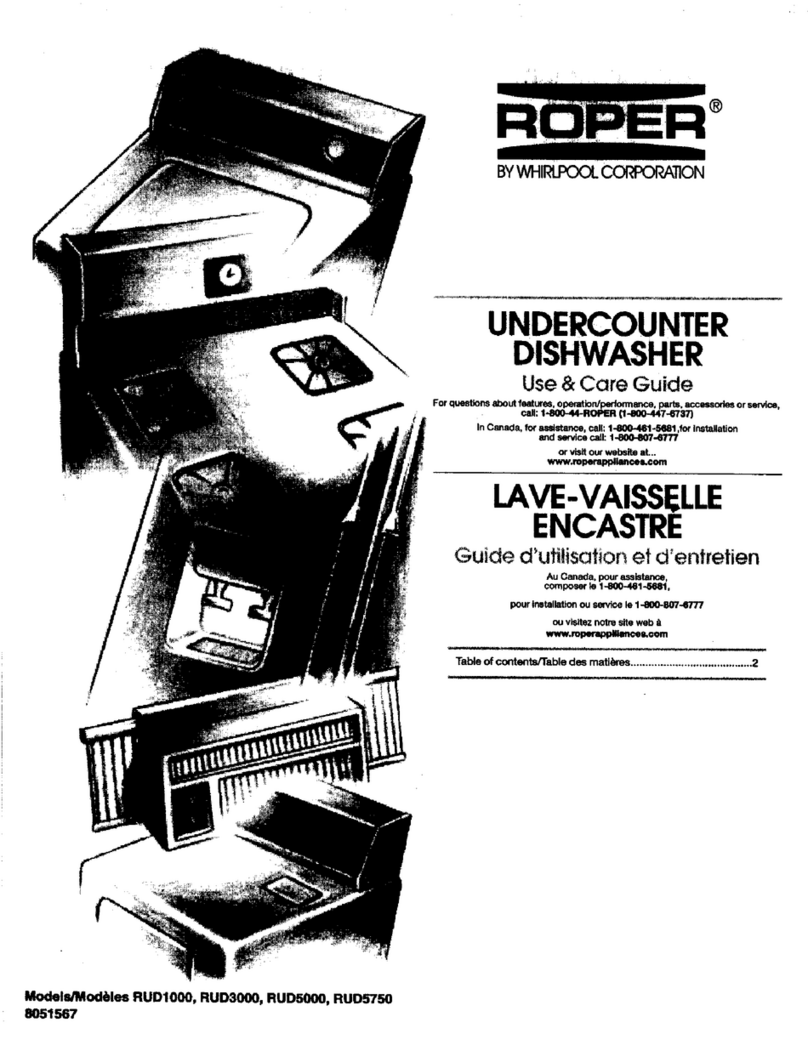
Roper
Roper RUD3000 User manual
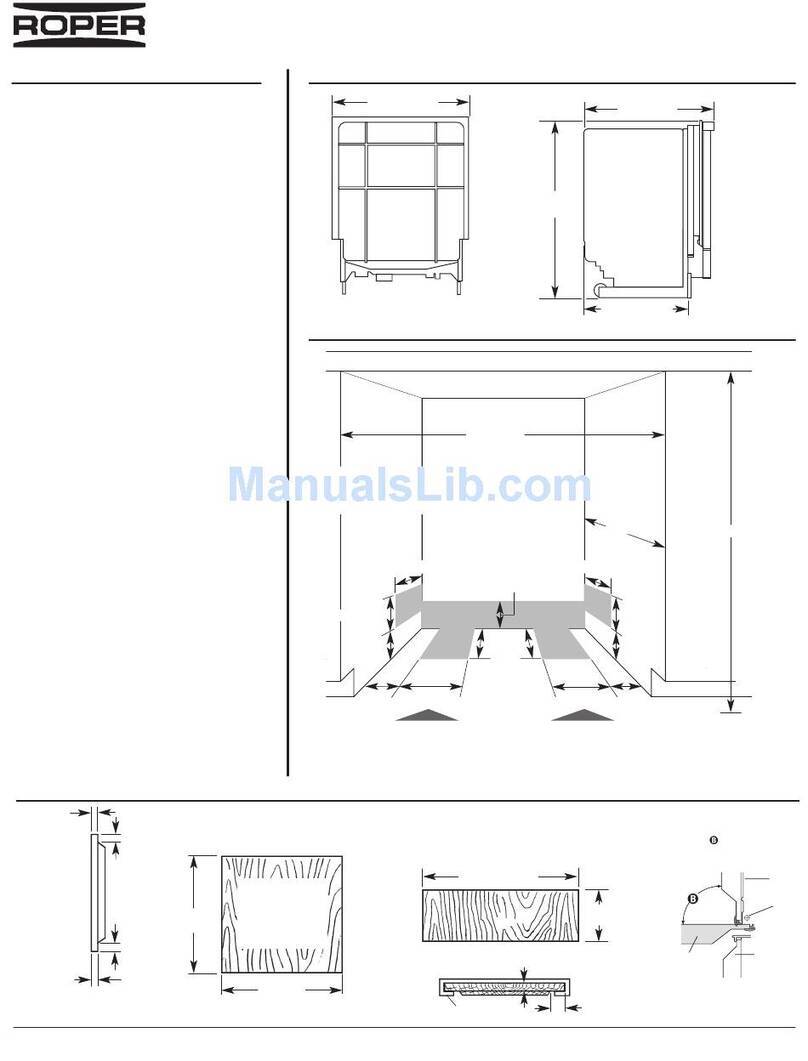
Roper
Roper RUD1000KB User instructions
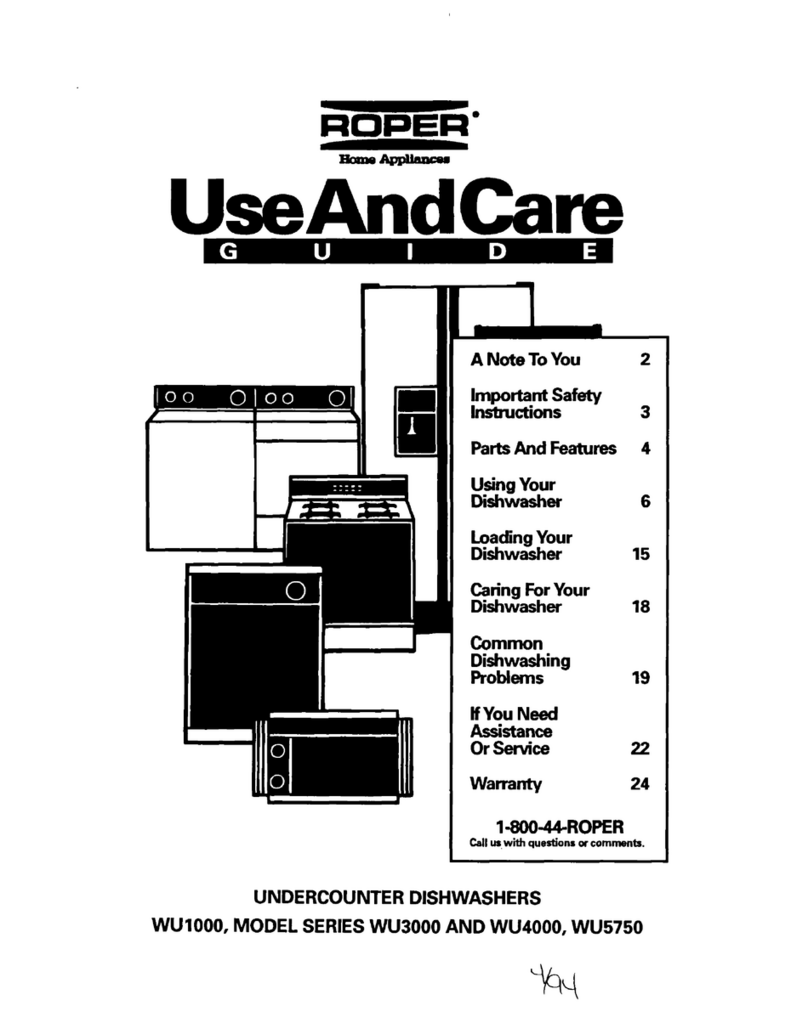
Roper
Roper WU3000 Series User manual
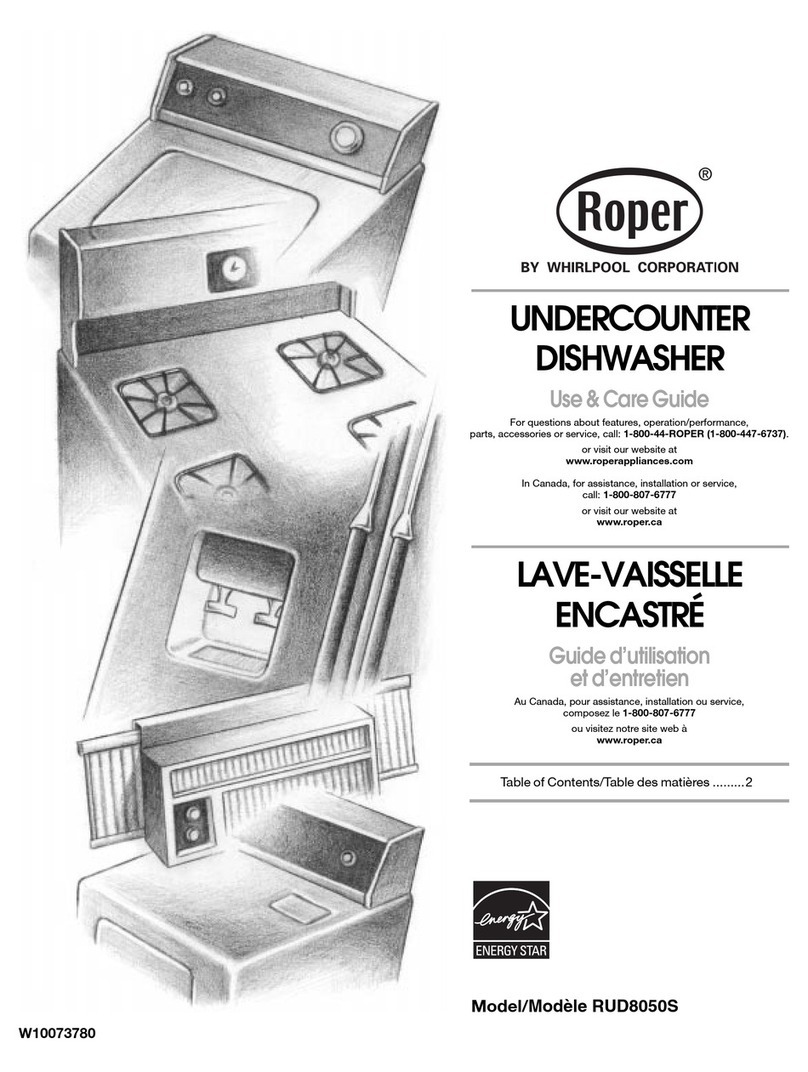
Roper
Roper RUD8050S User manual
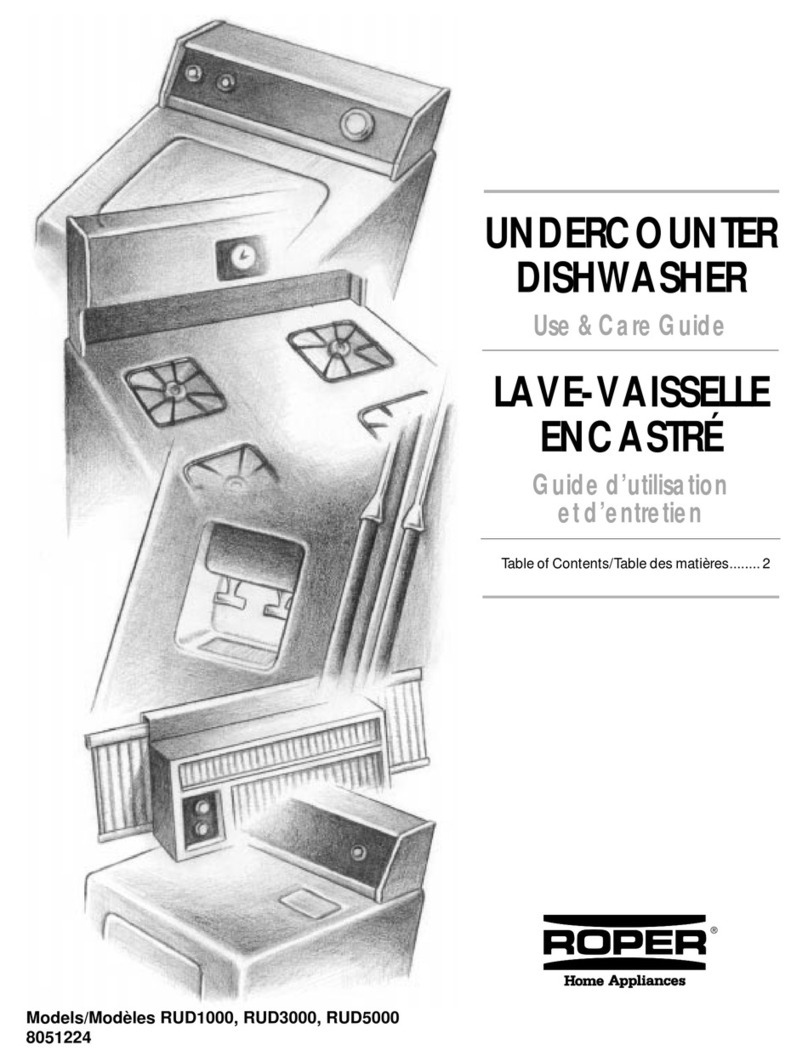
Roper
Roper RUD3000HB0 User manual
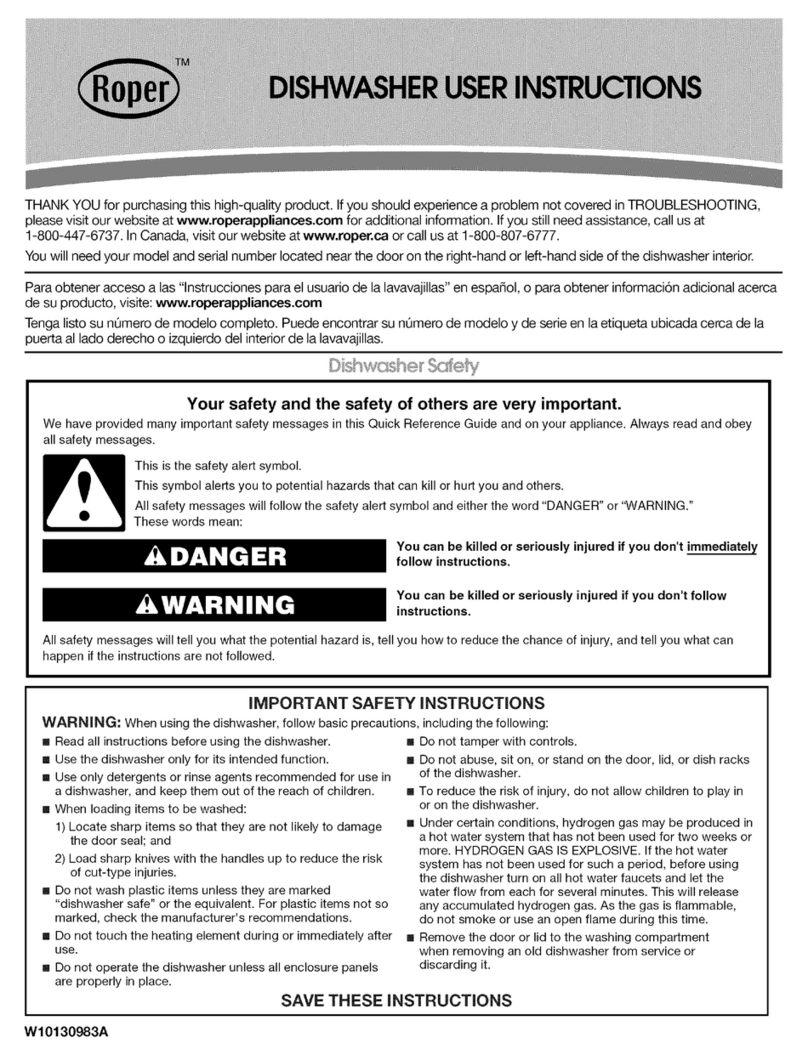
Roper
Roper RUD8050SD2 User manual
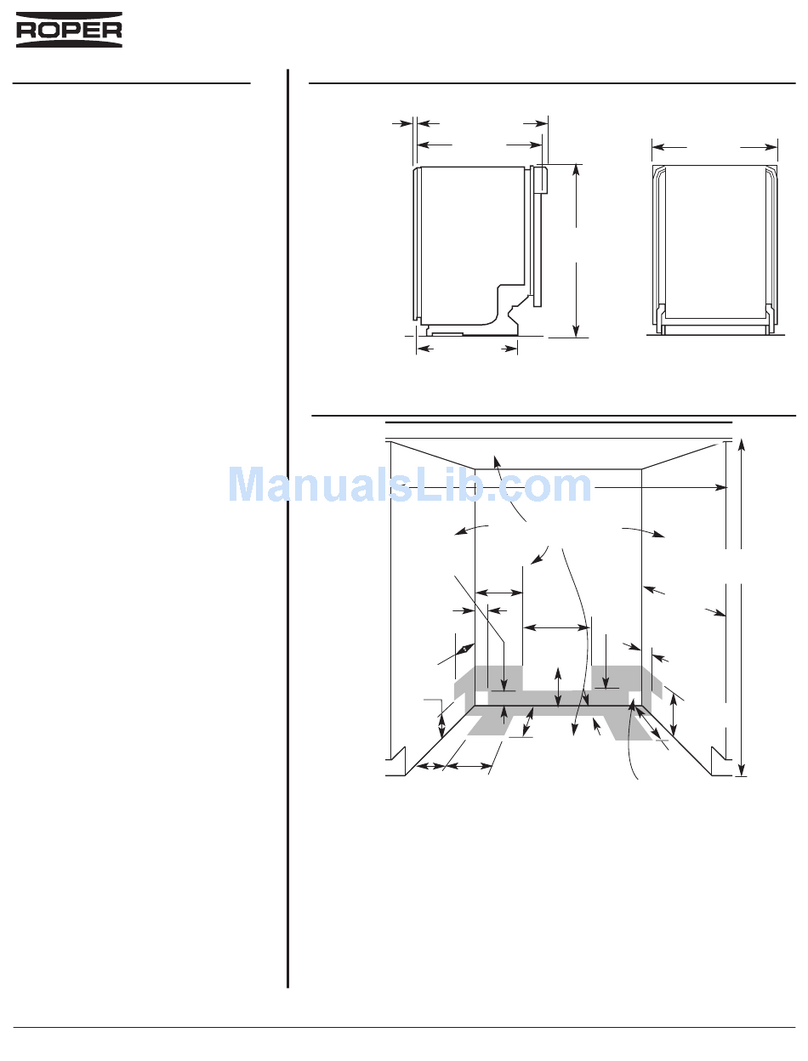
Roper
Roper RUD8000R User guide
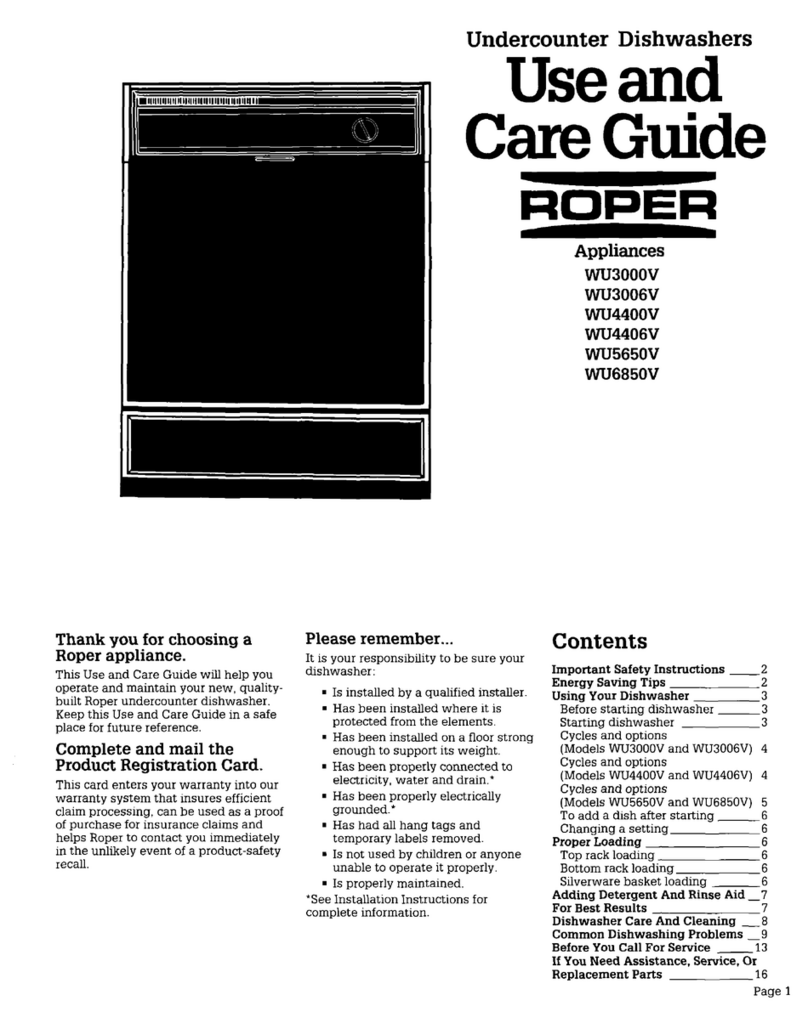
Roper
Roper WU3000V User manual
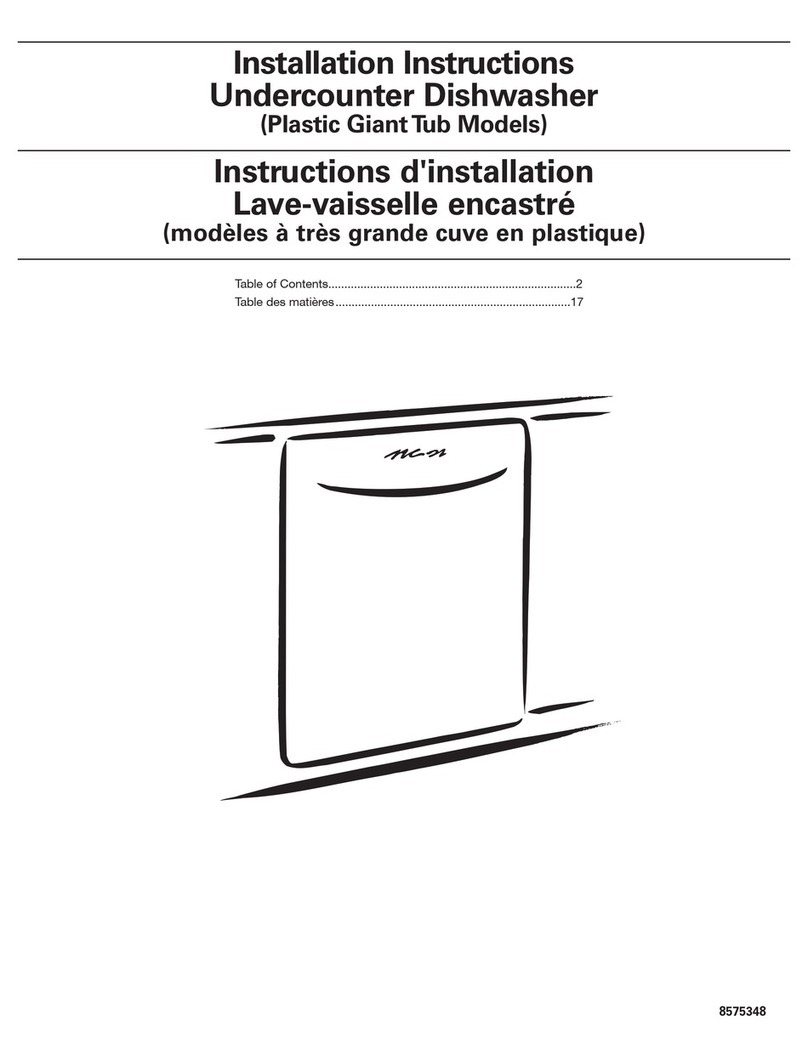
Roper
Roper Undercounter Dishwasher User manual

Roper
Roper RUD4000SB0 User manual
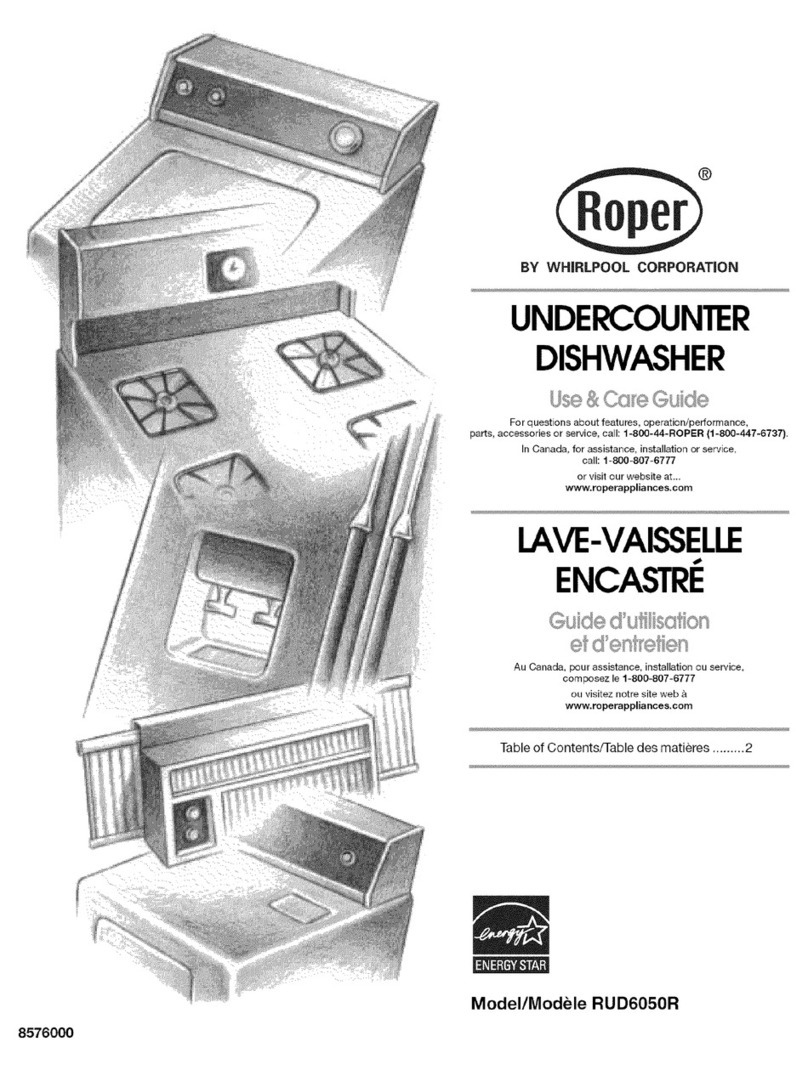
Roper
Roper RUD6050RD2 User manual
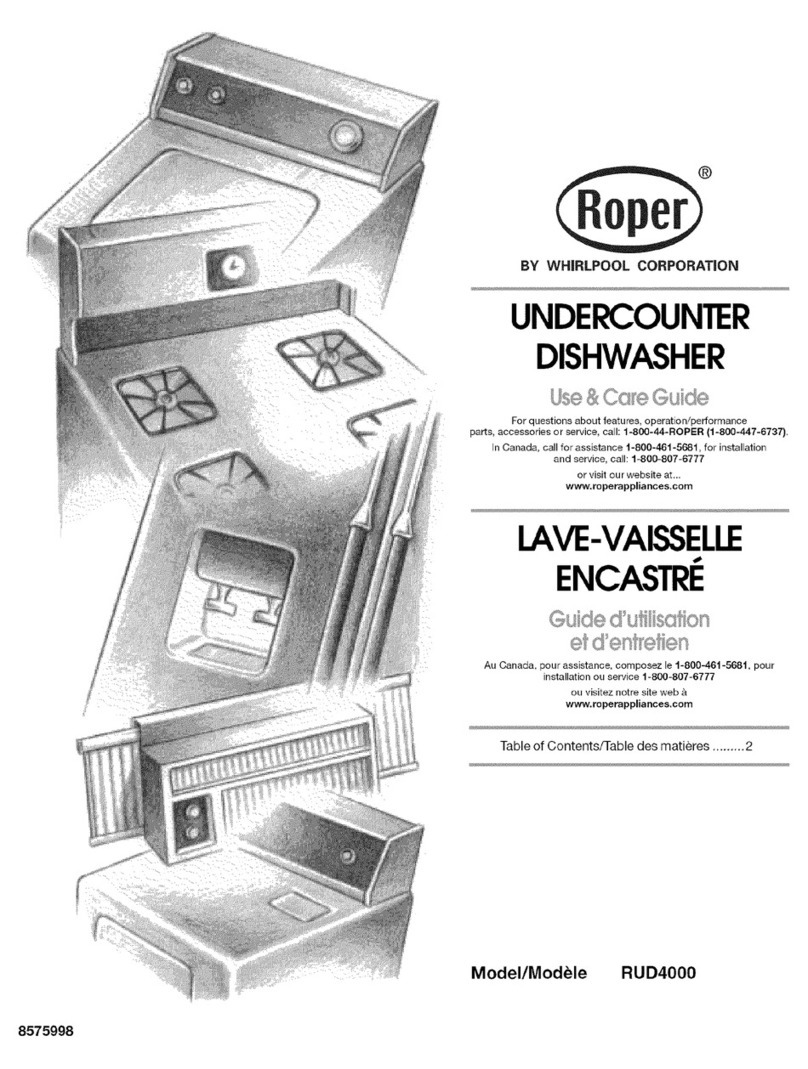
Roper
Roper RUD4500MQ2 User manual
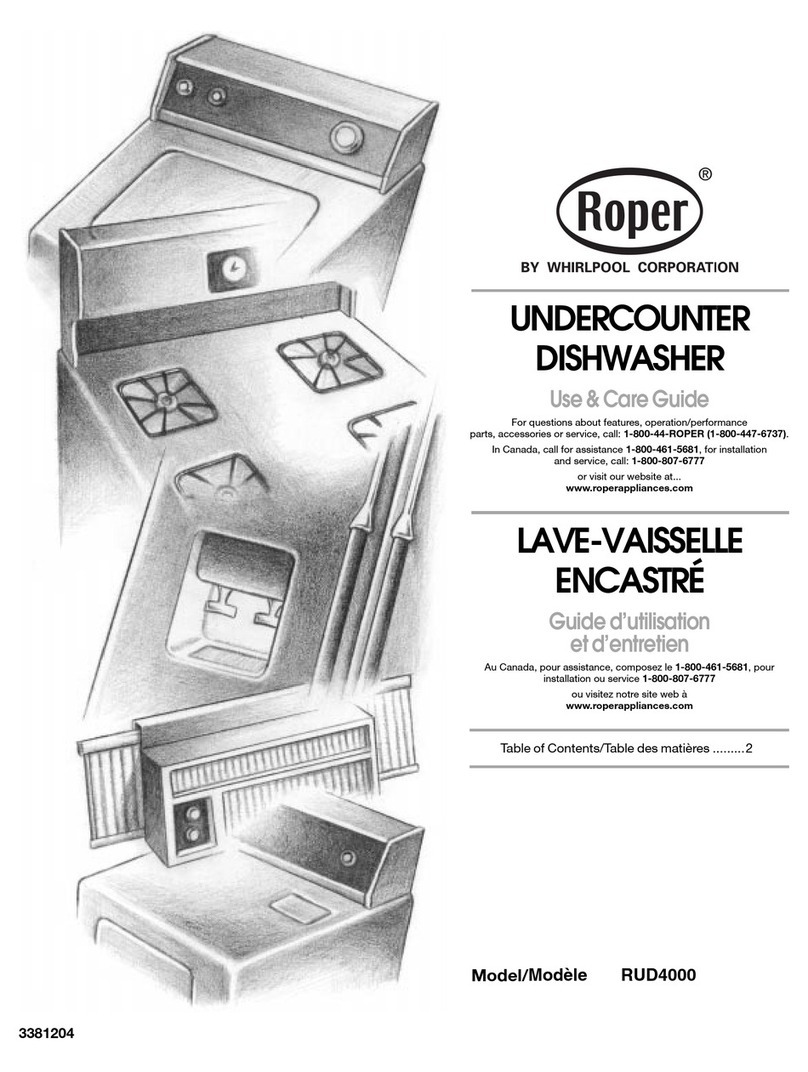
Roper
Roper rud4000 User manual
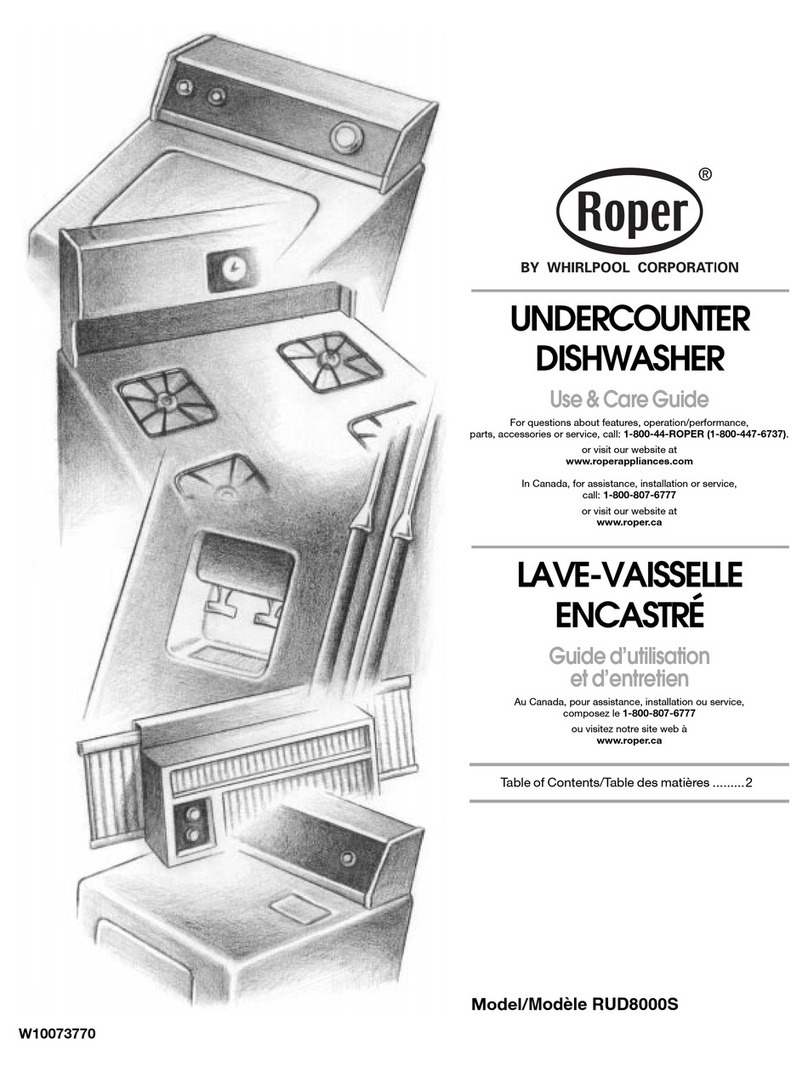
Roper
Roper RUD8000S User manual
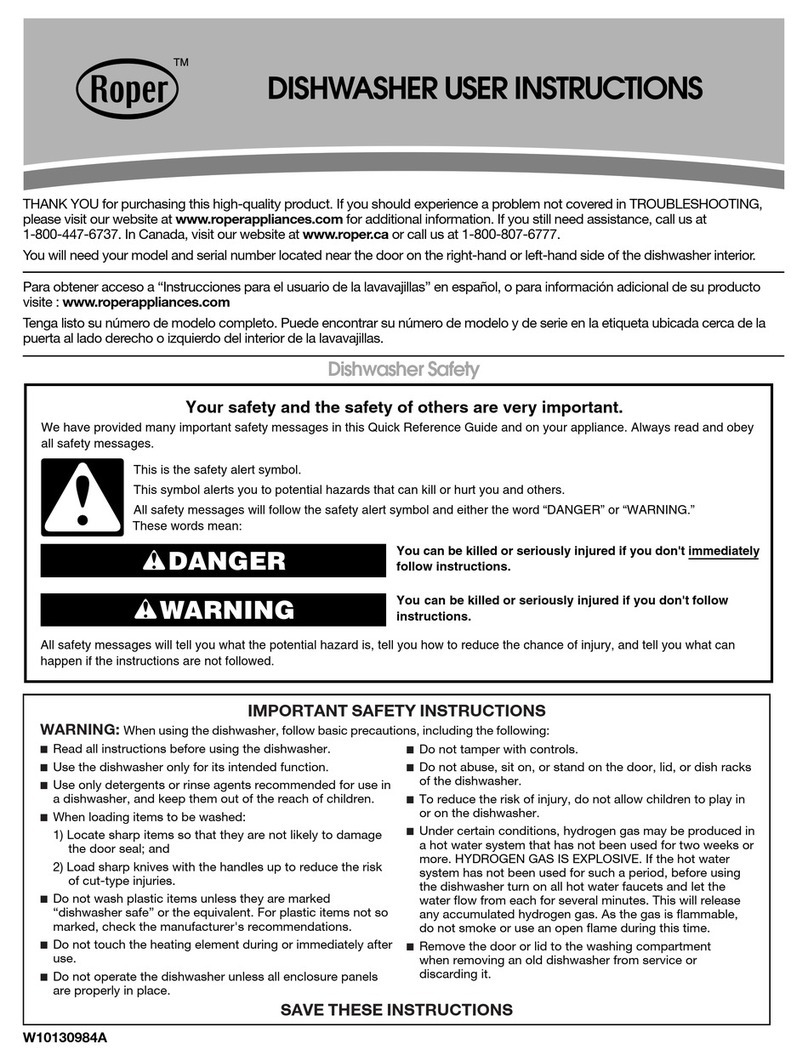
Roper
Roper RUD4500MB2 User manual

Roper
Roper RUD1000 User manual
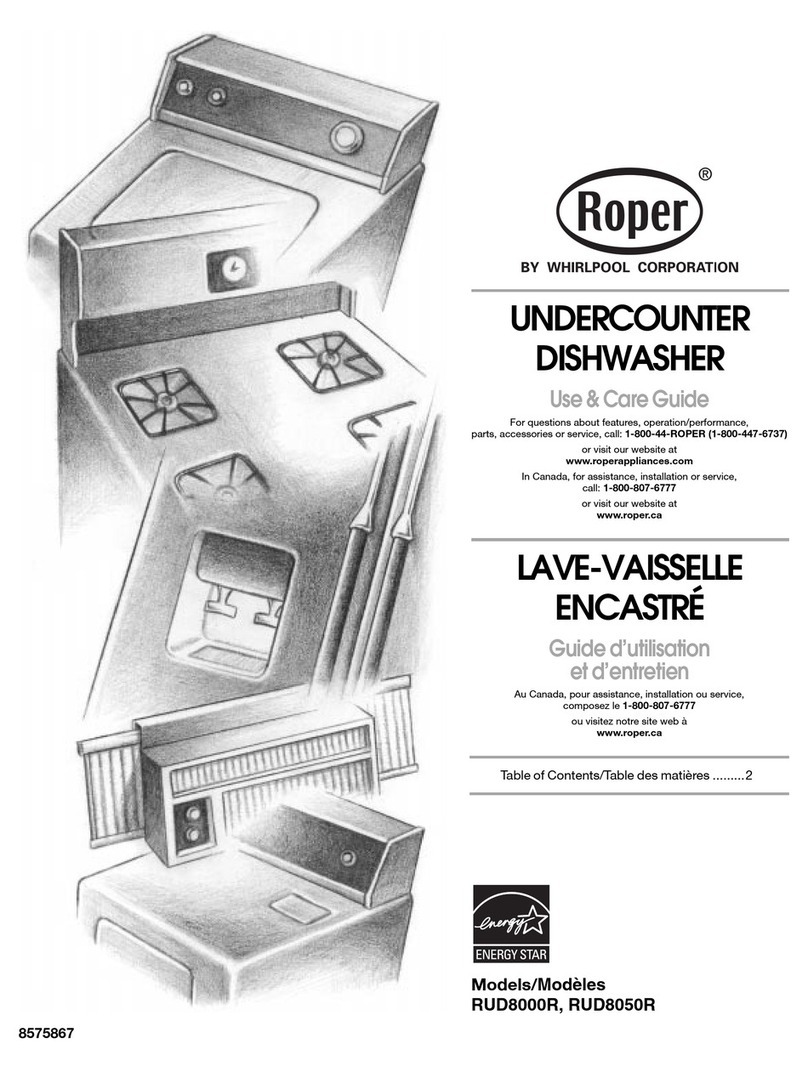
Roper
Roper RUD8000R User manual

Roper
Roper UNDERCOUNTER DISHWASHERS User manual



